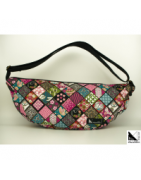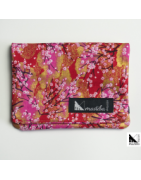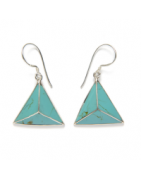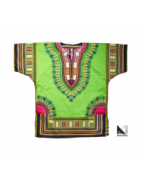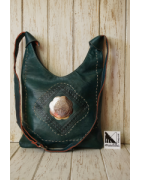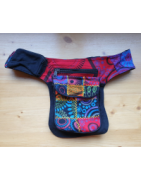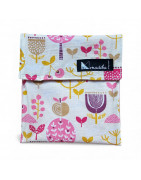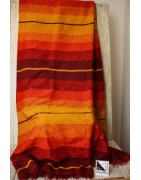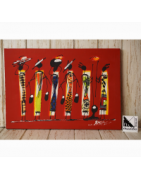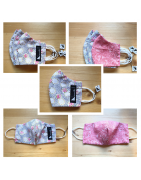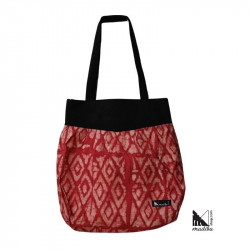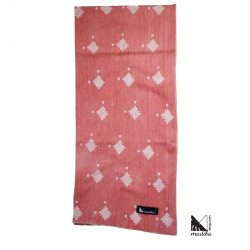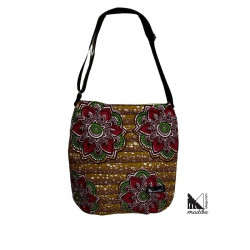Batik fabrics:
The technique for coloring cloth called "batik" is a very laborious dyeing technique that comes from Asia. Actually Batik, is a Javanese word from the voice ‘ambatik’, means “write with wax” in Javanese (from Java Island, in Indonesia).
It is known about the existence of the batik in Senegal since 1076, transmitted from Egypt to the Wolof people. The first wax-dyed batik garments were imported to African countries from Indonesia in the 19th century. They had immediate success and it did not take long to learn and adapt the manufacturing technique. The motifs of the traditional motifs of the traditional culture of each country or African zone were introduced very quickly in the designs. For those who know how to read it, the fabric design tells a story, which is often important for those who saw the garment.
The technique of batik was reserved for the women of the aristocracy. One of the reasons was because they had a lot of free time to devote to fabric manufacturing. And as you can imagine it was a rather tedious and slow process.
Usually batik fabrics, it can be said that they deal with everyday life (household chores, family gatherings, men hunting ...). On the other hand, there are also drawings of animals such as giraffes, elephants or antelopes.
What is it exactly?
Batik is a technique performed by hand that is used to paint fabrics and consists of applying wax on areas that do not want to be dyed (reserved areas), so that it does not allow the dye to penetrate during dyeing baths, and is fixed in Unreserved areas. This process can be repeated as many times as desired, allowing colors to be superimposed, thereby achieving a rich variety of nuances.
The property that has the wax of cracking once hardened, allows broken lines to be drawn or cracked. This "cracking" constitutes the differentiating seal of this dyeing technique of similar ones.
Samba and Rob are local artists from the Casamance region in Senegal. They are dedicated to making pieces of cloth and clothing, which he paints by hand with the batik technique.
In Madibashop we love the art that these two artists put in their unique pieces and with them we are dedicated to making our own items, from toiletry bags to handbags and bags. Soon we will also make tablecloths and cushion covers. (At the moment we can manufacture them on request)
Kente fabrics:
Kente fabrics were manufactured by Akan workers in Ghana and used by the great kings and chiefs of West Africa, also considered sacred. They were made in looms in an artisanal way using cotton, silk and linen to make the strips that made up the fabric. Currently, the use of this fabric has become very popular, being used in important celebrations or ceremonies. The production of this fabric has been industrialized but there are still artisans who bet on a traditional production.
The kente fabric has its origin in the Ashanti people, belonging to Ghana. They are made in a town called Bonwire; and the legend tells that Kurugu and Ameyaw, two brothers of the town, went hunting and were hopelessly obnoxious to observe a spider weaving its web. Upon returning home, they dedicated themselves to making the first black and white fabric with a raffia tree.
According to the Ashanti tradition:
- Black represents Africa
- Red represents the blood of the ancestors
- Yellow represents gold
- Green represents the forest
Today Bronwire remains the most famous center for weaving kente fabrics.
Wax fabrics:
The manufacture of wax fabrics or wax fabrics dates back to the 19th century. The Dutch recruited soldiers from West Africa to strengthen their army in Indonesia. In that area, fabrics were produced by applying the wax on a cloth to create a pattern. The African soldiers of the Dutch army were amazed by the beauty and color of these fabrics, taking crafts and technique to their country of origin.
Seeing the Europeans (Dutch and English) the fascination of the Africans by wax fabrics they decided to manufacture them and at the end of the 19th century a Belgian printer developed a method for the application of resin on both sides of a cotton cloth, thus creating the wax of machine printing
In Europe, after a while, a method was developed for the application of resin on both sides of the cotton fabric, and that was the way the machine for printing wax was born, although printing was still not very successful and imperfections appeared on the prints.
On the other hand, in West Africa, Africans learned the technique and adapted it in such a way that wax fabrics were obtained without any imperfections.
The Dutch opened factories in Togo, Ghana, Ivory Coast, South Africa and the Democratic Republic of the Congo. The wax fabric market was booming and the rich and not so rich liked it equally.
These fabrics have become part of the social life of Africans, and they have become a symbol of social status, used as a gift of courtship, to include them in the dowry of women. There are also specifically funeral fabrics, fabrics to send suggestive messages or even threats.
What is wax fabric?
WAX, which means wax in English, is a method of stamping colors and wax that gives the fabric its name. These are 100% cotton pieces dyed with wax so that the colors penetrate both sides of the fabric and thus allow a better fixation of them. Actually the same traditional batik technique is used but mechanically.
The wax fabric is sold in pieces of 6 yards (5.30 meters by 1.15m wide) and each of them has a unique and unrepeatable print, which makes them an original and exclusive fabric. All of them are 100% cotton.
Characteristics:
-The wax fabrics shine on both sides of the textile,
- Your colors do not fade
- They are very resistant.
The wax (the wax) maintains the freshness of the colors over time and protects the textile from the sun and continuous washing.
How do we recognize the African Wax Fabric?
- Printing: both sides of the fabric have almost the same intensity.
- The irregular appearance of its crackle and its bubbling that is formed randomly giving its singularity and depth in the fabric. The bubbling is the small bubbles that prevent the coloring of the drawing.
African Wax Fabric and Fashion:
Wax fabrics are carried from Senegal to South Africa, through the Ivory Coast, Cameroon, Congo, the Wax Cloth is a symbol of Africa. Upon arrival, African women used them as sarongs, but over the years they have been integrated into African fashion at all levels reaching western fashion.
African designs have a wide variety of bright colors, geometric patterns and ethnic symbols that fulfill a communicative and social function that goes beyond fashion. The fact that African fashion is crossing borders helps the West to know African identity, and positively affects the growth of the continent that is the future of the planet.

